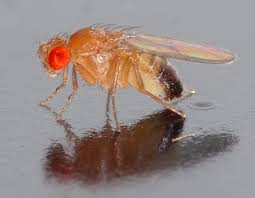An Introduction to Drosophila Melanogaster
4/3/2014
JoVE Science Education Database. Model Organisms I: yeast, Drosophila and C. elegans. An Introduction to Drosophila melanogaster. Journal of Visualized Experiments, Cambridge, MA, doi: 10.3791/5082 (2014).
Drosophila melanogaster, also known as the fruit fly, is a powerful model organism widely used in biological research that has made significant contributions to the greater scientific community over the last century. First, this video introduces the fruit fly as an organism, including its physical characteristics, life cycle, environment, and diet. Next, the reasons why fruit flies make an excellent model organism are discussed. For example, fruit flies are inexpensive to maintain in the laboratory, have simplified genetics, and short generation times allow for quick experiments with high sample numbers. Then, key discoveries and important Drosophila researchers, such as Thomas Hunt Morgan are profiled. Finally, applications ofDrosophila research, ranging from genetics to cardiac and neurological development and disease, are provided. This video serves as an overview of the highly-important and influential model organism that is Drosophila melanogaster.
Drosophila Maintenance and Care
Drosophila melanogaster, commonly known as fruit flies, are a frequently used model organism for life science research. Although starting a collection of these critters may seem as easy as leaving a banana on your kitchen counter for too long, a productive fly colony in the lab requires careful husbandry and maintenance.
This video demonstrates the necessary steps for maintaining a healthy fly stock. The overview begins with the preparation and storage of the yeast and sugar-containing media on which flies feed. Next, the vessels most commonly used for housing Drosophila are shown, as well as how and when to move flies between these containers. Finally, the presentation also includes examples of the ways in which housing and feeding conditions are manipulated for biological experiments.
Drosophila Development and Reproduction
One of the many reasons that make Drosophila an extremely valuable organism is that the molecular, cellular, and genetic foundations of development are highly conserved between flies and higher eukaryotes such as humans. Drosophila progress through several developmental stages in a process known as the life cycle and each stage provides a unique platform for developmental research. This video introduces each stage of the Drosophila life cycle and details the physical characteristics and major developmental events that occur during each stage. Next, the video discusses the genetic regulation of pattern formation, which is important for establishing the body plan of the organism and specifying individual tissues and organs. In addition, this video gives an overview of Drosophila reproduction, and how to use the reproductive characteristics of Drosophila to set up a genetic cross. Finally, we discuss examples of how the principles of Drosophila development and reproduction can be applied to research. These applications include RNA interference, behavioral assays of mating behaviors, and live imaging techniques that allow us to visualize development as a dynamic process. Overall, this video highlights the importance of understanding development and reproduction in Drosophila, and how this knowledge can be used to understand development in other organisms.
Drosophila Larval IHC
Immunohistochemistry (IHC) is a technique used to visualize the presence and location of proteins within tissues. Drosophila larvae are particularly amenable to IHC because of the ease with which they can be processed for staining. Additionally, the larvae are transparent, meaning that some tissues can be visualized without the need for dissection.
In IHC, proteins are ultimately detected with antibodies that specifically bind to “epitopes” within the protein of interest. In order to preserve these epitopes, tissues must be fixed prior to staining. Furthermore, in order for antibodies to penetrate membranes, cells must be permeabilized with detergents. This video article offers a detailed view of the reagents, tools, and procedures necessary for the staining of dissected larval tissues, including fixation, blocking, and staining steps. Also featured is a demonstration of tissue mounting techniques for fluorescence microscopy. Finally, examples of the broad range of applications for these techniques (and some variations upon them) are provided.
Drosophila melanogaster Embryo and Larva Harvesting and Preparation
Drosophila melanogaster embryos and larvae are easy to manipulate and develop rapidly by mechanisms that are analogous to other organisms, including mammals. For these reasons, many researchers utilize fly embryos and larvae to answer questions in diverse fields ranging from behavioral to developmental biology. Prior to experimentation, however, the embryos and larvae must first be collected.
This video will first demonstrate how “egg-laying cups” are used to collect Drosophila embryos on agar plates. The harvest and dechorionation of embryos will then be described. Next, the video will demonstrate how to identify and manipulate Drosophila in one of the three larval stages that follow the embryo stage. Finally, examples of some of the ways in which fly embryos and larvae are used in biological research are provided.

 Immune & Epithelial Interactions
Immune & Epithelial Interactions




